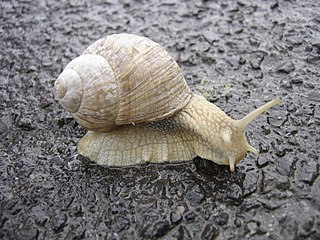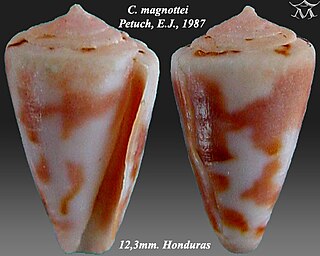
A snail is a shelled gastropod. The name is most often applied to land snails, terrestrial pulmonate gastropod molluscs. However, the common name snail is also used for most of the members of the molluscan class Gastropoda that have a coiled shell that is large enough for the animal to retract completely into. When the word "snail" is used in this most general sense, it includes not just land snails but also numerous species of sea snails and freshwater snails. Gastropods that naturally lack a shell, or have only an internal shell, are mostly called slugs, and land snails that have only a very small shell are often called semi-slugs.

A seashell or sea shell, also known simply as a shell, is a hard, protective outer layer usually created by an animal or organism that lives in the sea. The shell is part of the body of the animal. Empty seashells are often found washed up on beaches by beachcombers. The shells are empty because the animal has died and the soft parts have decomposed or been eaten by another animal.

Hermit crabs are anomuran decapod crustaceans of the superfamily Paguroidea that have adapted to occupy empty scavenged mollusc shells to protect their fragile exoskeletons. There are over 800 species of hermit crab, most of which possess an asymmetric abdomen concealed by a snug-fitting shell. Hermit crabs' soft (non-calcified) abdominal exoskeleton means they must occupy shelter produced by other organisms or risk being defenseless.

Aliger gigas, originally known as Strombus gigas or more recently as Lobatus gigas, commonly known as the queen conch, is a species of large sea snail, a marine gastropod mollusc in the family of true conches, the Strombidae. This species is one of the largest molluscs native to the Caribbean Sea, and tropical northwestern Atlantic, from Bermuda to Brazil, reaching up to 35.2 centimetres (13.9 in) in shell length. A. gigas is closely related to the goliath conch, Lobatus goliath, a species endemic to Brazil, as well as the rooster conch, Aliger gallus.

Sea snail is a common name for slow-moving marine gastropod molluscs, usually with visible external shells, such as whelk or abalone. They share the taxonomic class Gastropoda with slugs, which are distinguished from snails primarily by the absence of a visible shell.

The Trochidae, common name top-snails or top-shells, are a family of various sized sea snails, marine gastropod molluscs in the subclass Vetigastropoda. This family is commonly known as the top-snails because in many species the shell resembles a toy spinning top.

Calliostoma is a genus of small to medium-sized sea snails with gills and an operculum, marine gastropod molluscs within the family Calliostomatidae, the Calliostoma top snails. Previously this genus was placed within the family Trochidae. Calliostoma is the type genus of the family Calliostomatidae.

The siphonal canal is an anatomical feature of the shells of certain groups of sea snails within the clade Neogastropoda. Some sea marine gastropods have a soft tubular anterior extension of the mantle called a siphon through which water is drawn into the mantle cavity and over the gill and which serves as a chemoreceptor to locate food. Siphonal canals allow for active transport of water to sensory organs inside the shell. Organisms without siphonal canals in their shells rely on passive or diffuse transport or water into their shell. Those with siphonal canals have a direct inhalant stream of water that interacts with sensory organs to detect concentration and direction of a stimulus, such as food or mates. In certain groups of carnivorous snails, where the siphon is particularly long, the structure of the shell has been modified in order to house and protect the soft structure of the siphon. Thus the siphonal canal is a semi-tubular extension of the aperture of the shell through which the siphon is extended when the animal is active.

Hipponix, common name hoof snails or hoof shells, is a genus of small sea snails with limpet-like shells, marine gastropod molluscs in the family Hipponicidae, the hoof snails. Many of the species in this genus have white shells.

Sea anemones are a group of predatory marine invertebrates constituting the order Actiniaria. Because of their colourful appearance, they are named after the Anemone, a terrestrial flowering plant. Sea anemones are classified in the phylum Cnidaria, class Anthozoa, subclass Hexacorallia. As cnidarians, sea anemones are related to corals, jellyfish, tube-dwelling anemones, and Hydra. Unlike jellyfish, sea anemones do not have a medusa stage in their life cycle.

Vetigastropoda is a major taxonomic group of sea snails, marine gastropod mollusks that form a very ancient lineage. Taxonomically the Vetigastropoda are sometimes treated as an order, although they are treated as an unranked clade in Bouchet and Rocroi, 2005.

Cittarium pica, common name the West Indian top shell or magpie shell, is a species of large edible sea snail, a marine gastropod mollusk in the family Tegulidae. This species has a large black and white shell.

Freshwater snails are gastropod mollusks that live in fresh water. There are many different families. They are found throughout the world in various habitats, ranging from ephemeral pools to the largest lakes, and from small seeps and springs to major rivers. The great majority of freshwater gastropods have a shell, with very few exceptions. Some groups of snails that live in freshwater respire using gills, whereas other groups need to reach the surface to breathe air. In addition, some are amphibious and have both gills and a lung. Most feed on algae, but many are detritivores and some are filter feeders.

Conus lugubris is a species of sea snail, a marine gastropod mollusk in the family Conidae, the cone snails and their allies.

Conus magnottei is a species of sea snail, a marine gastropod mollusk in the family Conidae, the cone snails and their allies.

Turris brevicanalis is a species of sea snail, a marine gastropod mollusk in the family Turridae, the turrids.

Nucella squamosa, common name the scaly dogwhelk, is a species of sea snail, a marine gastropod mollusk in the family Muricidae, the murex snails or rock snails.

Cymbiola nobilis is a species of sea snail, a marine gastropod mollusk in the family Volutidae, the volutes. The snail's shell is commonly collected in the sea shell trade, which has resulted in overharvesting of the snail.

Sabia is a genus of small sea snails, limpet-like marine gastropod molluscs in the family Hipponicidae, the hoof shells or hoof snails.

Kelletia kelletii, common name Kellet's whelk, is a species of large sea snail, a whelk, a marine gastropod mollusc in the whelk family Austrosiphonidae.




















